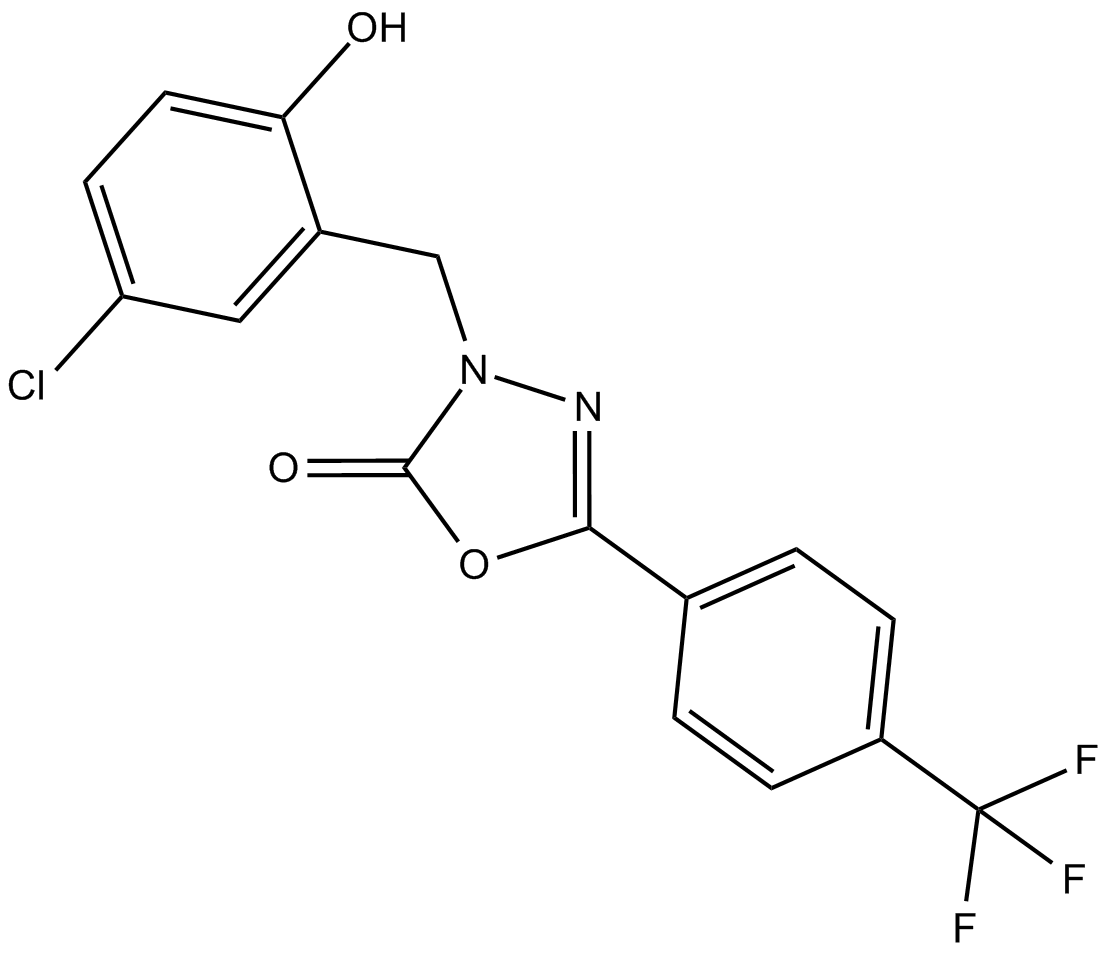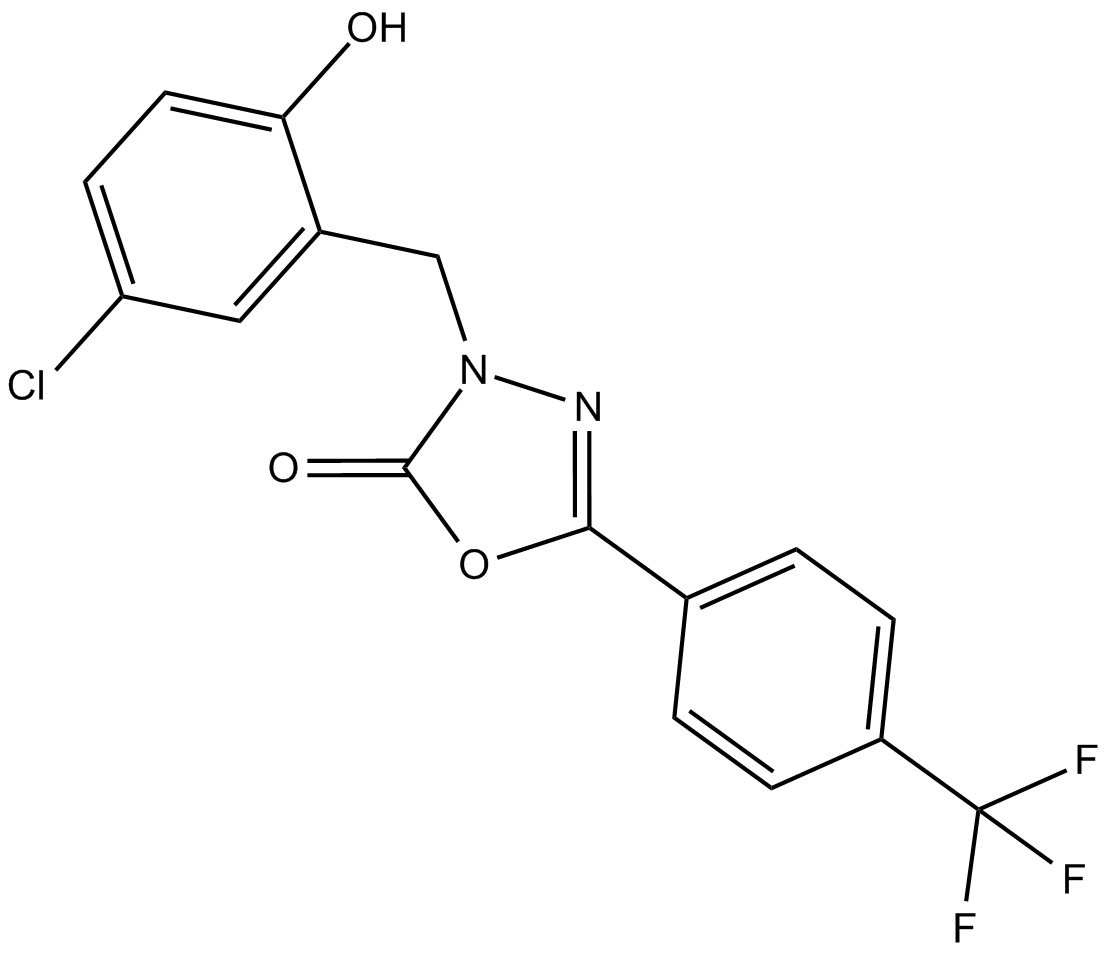BMS 191011
BMS 191011 is a maxi-K channel opener [1].
Maxi-K channels consist of a pore-forming α subunit and a regulatory β subunit. Maxi-K channels are of a high Ca2+ sensitivity [2].
Bath application of BMS-191011 at a concentration of 20 μM strongly reduced the calcium transients. This effect was associated with bursts of bAPs (100 Hz) recorded from Fmr1-/y dendrites without affecting those recorded from wild-type dendrites. This treatment decreased dendritic calcium transients of Fmr1-/y neurons to baseline levels of wild-type neurons [3]. In normoxia, BMS-191011 significantly induced cell death. This effect was indicted by the increases in propidium iodide (PI) uptake by 9.4 ± 2.4 and 16.8 ± 2.1% at 12 and 24 h treatments, respectively. At 12 h and then 24 h, the cellular [ATP] was decreased to 83.4 ± 3.1 and further to 72.3 ± 2.8%. During hypoxia, these effects were increased by ~2-fold in all time points and measurements. PI uptake was increased to 15.1 ± 1.8 at 12 h and then 40.7 ± 1.7% at 24 h. Cellular [ATP] was decreased to 77.8 ± 1.9 at 12 h and then to 43.3 ± 3.4% at 24 h [4].
In male Wistar rats of 8 to 10 weeks old, an i.v. administration with BMS-191011 at 10-100 µg/kg/min increased the retinal arteriol diameter, whereas it did not significantly affect mean arterial pressure and heart rate. Intravitreal injection of iberiotoxin at a dose of 20 pmol/eye significantly attenuated the vasodilator responses of retinal arterioles to BMS-191011 [5]. BMS-191011 demonstrated efficacy as an opener of the cloned large-conductance Ca2+-activated potassium (maxi-K) channel in in vivo stroke models [6].
References:
[1]. Hewawasam P, Ding M, Chen N, et al. Synthesis of water-soluble prodrugs of BMS-191011: a maxi-K channel opener targeted for post-stroke neuroprotection. Bioorganic & medicinal chemistry letters, 2003, 13(10): 1695-1698.
[2]. Valverde MA, Rojas P, Amigo J, et al. Acute activation of Maxi-K channels (hSlo) by estradiol binding to the β subunit. Science, 1999, 285(5435): 1929-1931.
[3]. Zhang Y, Bonnan A, Bony G, et al. Dendritic channelopathies contribute to neocortical and sensory hyperexcitability in Fmr1-/y mice. Nature neuroscience, 2014, 17(12): 1701-1709.
[4]. Gu XQ, Pamenter ME, Siemen D, et al. Mitochondrial but not plasmalemmal BK channels are hypoxia-sensitive in human glioma. Glia, 2014, 62(4): 504-513.
[5]. Mori A, Suzuki S, Sakamoto K, et al. BMS-191011, an opener of large-conductance Ca2+-activated potassium channels, dilates rat retinal arterioles in vivo. Biological and Pharmaceutical Bulletin, 2011, 34(1): 150-152.
[6]. Romine JL, Martin SW, Meanwell NA, et al. 3-[(5-Chloro-2-hydroxyphenyl) methyl]-5-[4-(trifluoromethyl) phenyl]-1, 3, 4-oxadiazol-2 (3 H)-one, BMS-191011: Opener of Large-Conductance Ca2+-Activated Potassium (Maxi-K) Channels, Identification, Solubility, and SAR. Journal of medicinal chemistry, 2007, 50(3): 528-542.
| Physical Appearance | White solid |
| Storage | Store at RT |
| M.Wt | 370.71 |
| Cas No. | 202821-81-6 |
| Formula | C16H10ClF3N2O3 |
| Solubility | Soluble in DMSO |
| Chemical Name | 3-(5-chloro-2-hydroxybenzyl)-5-(4-(trifluoromethyl)phenyl)-1,3,4-oxadiazol-2(3H)-one |
| SDF | Download SDF |
| Canonical SMILES | Oc(cc1)c(CN2N=C(c3ccc(C(F)(F)F)cc3)OC2=O)cc1Cl |
| Shipping Condition | Small Molecules with Blue Ice, Modified Nucleotides with Dry Ice. |
| General tips | We do not recommend long-term storage for the solution, please use it up soon. |
Quality Control & MSDS
- View current batch:
-
Purity = 98.00%
- COA (Certificate Of Analysis)
- MSDS (Material Safety Data Sheet)
- Datasheet
Chemical structure









